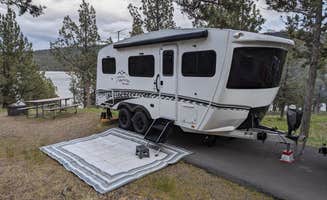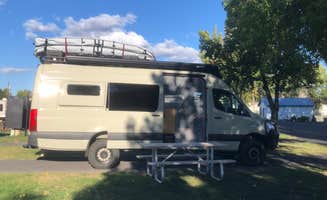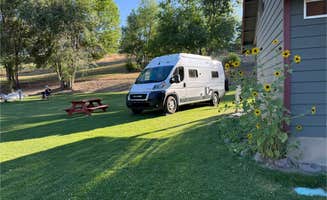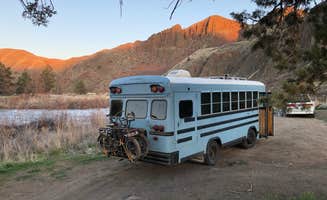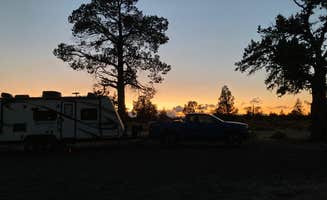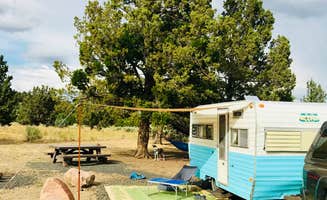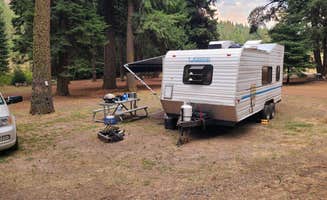Central Oregon's high desert environment features rolling juniper-covered hills and ponderosa forests at elevations ranging from 3,000-5,000 feet. This landscape creates distinct camping microclimates with temperature variations between river canyon sites and forested locations sometimes differing by 15-20 degrees. Summers remain dry with temperatures regularly reaching 90°F during July and August while nighttime temperatures can drop significantly even in peak season.
What to do
Fishing access: At Walton Lake campground in the Ochoco National Forest, the small lake provides excellent trout fishing opportunities. "The lake is little but charming... There were kids kayaking and swimming in the lake and about a dozen people fishing," notes Heather W. The lake is regularly stocked, making it ideal for beginners or families.
Mountain biking: Trails near Cottonwood RV Park provide access to nearby Smith Rock State Park's extensive trail system. "Great facilities, close to Smith Rock State Park, close to Redmond for all your needs," says John D. Many trails accommodate various skill levels with routes ranging from beginner-friendly loops to technical descents.
Wildlife viewing: Early morning and dusk provide optimal wildlife viewing times throughout the region. "We saw some deer, one of those baby deer in my pictures was running and fell and slid, it was crazy. Then ran to mama to nurse," reports Amanda B. about her stay at Walton Lake. Bring binoculars to spot raptors, deer, and occasionally elk.
What campers like
Clean facilities: Crook County RV Park maintains exceptionally clean amenities. "Squeaky-clean RV park in excellent repair. Close to everything in the cute town of Prineville, on a scenic road bike route, across the street from the Crooked River and Rimrock Park with an elaborate frisbee golf course," says Kurt Z. The park features two Rivian destination chargers on site.
Easy access to hiking: Camping locations throughout Central Oregon provide convenient access to hiking trails. "There is a trail that runs around the lake which is a nice, easy hike," mentions Heather W. about Walton Lake. Many campgrounds offer direct trail connections or are located within 15-30 minutes of established trailheads.
Space between sites: Site spacing varies considerably between campgrounds. "The sites were clean with good flat spots for tents. They had fire pits, clean toilets, and very nice campsite hosts," reports Heather W. Some campgrounds offer more privacy than others, with national forest sites typically providing more separation than commercial RV parks.
What you should know
Water availability: Water access can be limited or nonexistent at primitive sites. "This is a hidden gem in the Ochoco National forest. It is pretty rustic with no water but does have 1 pit toilet that was clean but not stocked," notes Ashley B. about Cottonwood Campground. Bring sufficient water when staying at remote locations, particularly during summer months.
Pack-in, pack-out requirements: Many forest service campgrounds require visitors to pack out all trash. "There is no trash so it's pack in pack out. Which I will say a lot of people were not doing so I walked around and picked up a huge bag of garbage especially out of the fire pits," reports Ashley B. Bring trash bags and plan for proper waste disposal.
Seasonal closures: National forest campgrounds typically close during winter months. "Great camp hosts. A little scrunched together with some loud campers. Tiny lake but well stocked with trout. Campfires okay!! Nice biking and hiking trails," says Steven R. about Walton Lake, which operates May through October. Always check seasonal availability before planning trips, especially in spring and fall.
Tips for camping with families
Kid-friendly activities: Fish House Inn and RV Campground offers grassy sites ideal for families. "We stayed here as we had plans to visit John Day Fossil Beds National Monument the next day. We pulled our class B onto a lovely grassy FHU site," shares Kim G. The campground provides a convenient base for exploring nearby attractions.
Biking opportunities: Many campgrounds feature kid-friendly biking loops. "My boys loved riding their bikes around the campground (which is small enough that you can see them even if they are on the other side of the lake)," mentions Heather W. These safe riding environments allow children to explore while remaining within view.
Designated fishing areas: Some locations offer designated children's fishing access. "Across the street is a family park with a children's fishing pond that is stocked with rainbow trout for anyone 17 and under," notes Tessa W. about facilities near Crook County RV Park. These areas typically have easier access and higher success rates for young anglers.
Tips from RVers
Level sites: Deschute County Expo RV Park provides exceptionally level concrete pads. "With over a hundred concrete spaces, each with a grill, picnic table, water, sewer, and electric. But there's more! Fantastic showers, laundry and friendly staff," writes Lee O. The level sites minimize setup time and equipment needs.
Hookup availability: RV parks throughout Central Oregon offer various hookup configurations. "Stayed for one night in a full hook up site for $45. All of the lots were paved and kind of level. It was quiet for such a full area with some long term campers and a few families staying and very friendly," reports Tessa W. Full hookup sites typically cost $35-55 per night depending on location and amenities.
Size limitations: Not all campgrounds accommodate larger RVs. "We are teardroppers and generally shun RV parks, but this one was near a bike route we wanted to ride. We were surrounded by ginormous RVs. Very nice facilities, clean and modern, but they don't allow campfires at your site," shares MadMax about Crook County RV Park. Check length restrictions before booking, especially for units over 30 feet.


